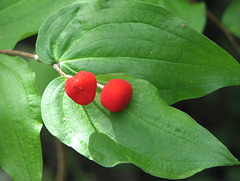Anne Elliott's photos with the keyword: Fairybells
Rough-fruited Fairybells / Prosartes trachycarpa
| 04 Nov 2015 |
|
This photo was taken on 23 August 2015, at Brown-Lowery Provincial Park. These berries of the Rough-fruited Fairybells plant always provide a lovely, bright splash of colour to come across in the forest. I will add a previously posted photo of the small, delicate, white flowers of this species in a comment box below.
The fruit can be green, turning yellow, to orange or red, and they are pretty in all these colours, each one being about 1 cm across. They have a rough surface, but look rather like velvet. Fairybells is a native plant, belonging to the Lily family, and grows in moist deciduous and mixedwood forests.
After visiting my daughter in hospital the day before, I thought I had better get out and do a bit of walking, so I drove SW of the city and plucked up my courage and went into Brown-Lowery. I only went in a short way, but managed to find a few fungi fit to photograph. The light is never good in the forest, but the sun managed to come through and touch a few of the mushrooms.
I met a couple of delightful young women along the path. I tried to point out an American Three-toed Woodpecker that was unfortunately very high up in a tree and barely visible. I had seen two others further along the path. Also lots of small birds, some of which were Warblers, but they were much too fast and distant for me to get photos. Then we got talking about mushrooms : ) Had a very interesting and enjoyable chat with them.
Rough-Fruited Fairybells / Prosartes trachycarpa
| 03 Aug 2015 |
|
Note: this is NOT my main photo today - the Savannah Sparrow is.
On 23 July 2015, five of us spent the day botanizing the land belonging to Darryl Teskey, SW of Calgary and W of Millarville (maybe a 40-minute drive from Calgary). This was the first time I had been there and I'm so glad I went - I would have missed all sorts of things, including a family of Ruffed Grouse and several fungi. These Grouse were the rare rufous-morph, and we startled them when we were walking through the forest in their direction. Usually, you don't see Grouse because they are so well-hidden. When you get fairly close (sometimes very close) to them, they suddenly "explode" from the tangle of shrubs and plants of the forest floor, making ones heart beat fast!
Our walk took us over grassland and through forest, everywhere treacherous with so many fallen logs which were often barely visible. I have never, ever seen so many tiny Skipper butterflies - there must have been hundreds or even thousands of these bright orange beauties that were flying or perched on flowers of every colour.
Fortunately, the rain stayed away until we started driving back to Calgary. Quite a lot of black clouds, reminding me of the tornado that passed through Calgary just the day before (22 July 2015).
Our purpose, as always, was to find and list everything that we saw - wildflowers, trees, grasses, birds, insects, fungi, etc.. Our leader then compiles an extensive list of our finds and this is later sent to the landowner, along with any photos that we might take. Always a win/win situation, as the landowner then has a much better idea of just what is on his property, and we have a most enjoyable day. This summer, with quite a few botanizing outings like this, plus two 3-day trips to Waterton Lakes National Park, I am so far behind with the photos that I need to edit and e-mail!
Fairybells
| 09 Dec 2007 |
|
I always love to see the brilliant orange or red berries that the Fairybells plant produces. They have a rough textured surface, like velvet. The leaves are very pretty in fall.
Fairybells fruit
| 01 Oct 2009 |
|
The velvety berries of the Rough-fruited Fairybells plant are dotting the forest with bright red at the moment. These were growing on Erik Butters' ranchland, north west of Calgary, three days ago.
"Fairybells produce velvety red berries 8-10 mm in diameter usually in groups of two or three. As the berries ripen, their colour varies from green, to yellow, orange and finally a bright red colour. They may also display a slightly warted appearance on the surface. They are edible, but mealy and tasteless - better to leave them for the grouse and rodents that find them tasty." From www.mountainnature.com .
True colours of fall
| 14 Nov 2009 |
|
The autumn leaves and the velvety fruit of the Fairybells wildflower are so bright and colourful in the forest. The fruit can be green, turning yellow, to orange or red, and they are pretty in all these colours, each one being about 1 cm across. Fairybells is a native plant, belonging to the Lily family, and grows in moist deciduous and mixedwood forests.
Fairybells
| 23 Jun 2009 |
|
These dainty, little, native wildflowers belonging to the Lily family grow in moist deciduous and mixedwood forests. The bell-shaped flowers are greenish yellow and 1-2 cm long. These plants produce velvety, deep red berries.
Fairybells
| 03 Jun 2008 |
|
We saw this wildflower, Fairybells, during our walk deep in the forest in Brown-Lowery Provincial park yesterday. Although we have seen Fairybells many times before, these particular flowers look slightly different. Maybe we will find out why : )?
Jump to top
RSS feed- Anne Elliott's latest photos with "Fairybells" - Photos
- ipernity © 2007-2025
- Help & Contact
|
Club news
|
About ipernity
|
History |
ipernity Club & Prices |
Guide of good conduct
Donate | Group guidelines | Privacy policy | Terms of use | Statutes | In memoria -
Facebook
Twitter







